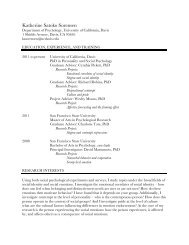The Psychology of Creativity:
The Psychology of Creativity:
The Psychology of Creativity:
You also want an ePaper? Increase the reach of your titles
YUMPU automatically turns print PDFs into web optimized ePapers that Google loves.
History <strong>of</strong> <strong>Creativity</strong> Research 15<br />
Quantitative Methods<br />
Both measurement and statistics had come a long way since Galton’s first attempts at making psychology a<br />
quantitative science. Powerful statistical techniques like multiple regression analysis, factor analysis, path analysis,<br />
structural equation modeling, and time-series analysis enabled psychologists to fathom aspects <strong>of</strong> creativity that<br />
were inaccessible at the beginning <strong>of</strong> the 20th century. But even more significant, in my view, was the development<br />
<strong>of</strong> new measurement approaches. No statistical analysis, no matter how sophisticated, can do anything if certain<br />
variables are unmeasured or measured poorly. <strong>The</strong>se measurement advances fall into two categories: the<br />
psychometric and the historiometric.<br />
Psychometrics. <strong>The</strong> prototype <strong>of</strong> psychometric assessment is the intelligence test. Yet as already<br />
mentioned, intelligence has very little to do with creativity. It seems that the cognitive processes that underlie<br />
creativity are not the kind tapped in the typical “IQ test.” This has led several psychologists to introduce measures<br />
that directly assess the mental processes involved in creative thought. For example, Mednick (1962) theorized that<br />
creativity requires the capacity to generate remote associations that can connect hitherto disparate ideas. He<br />
implemented this theory by devising the Remote Association Test, or RAT, that has seen considerable use in<br />
subsequent research. A person taking the RAT must identify a word that has an associative linkage with three<br />
separate stimulus words (e.g., associating the word “chair” with the given words “wheel, electric, high”).<br />
Even more popular are the measures that Guilford (1967) devised to assess various kinds <strong>of</strong> divergent<br />
thinking. Divergent thinking is the capacity to generate a great variety <strong>of</strong> responses to a given set <strong>of</strong> stimuli. Unlike<br />
convergent thinking, which aims at the single most correct response, ideational productivity is emphasized. A<br />
specific instance is the Unusual Uses test, which asks research participants to come up with as many uses as possible<br />
for ordinary objects, such as a toothpick or paperclip. <strong>The</strong> participants’ responses can then be scored for fluency<br />
(number <strong>of</strong> responses), flexibility (number <strong>of</strong> distinct categories to which the responses belong), and originality<br />
(how rare the response is relative to others taking the test).<br />
Process measures <strong>of</strong> creativity operate under the assumption that creativity requires the capacity to engage<br />
in somewhat distinctive cognitive processes. Not all psychologists agree with this position. Instead, some have<br />
argued that creative individuals appear to have distinctive non-cognitive characteristics that set them apart from<br />
persons who fail to display creativity. This has led some researchers to propose that creativity be assessed by<br />
personality-based measures. <strong>The</strong> most frequently used instruments assess creativity via the personality
















